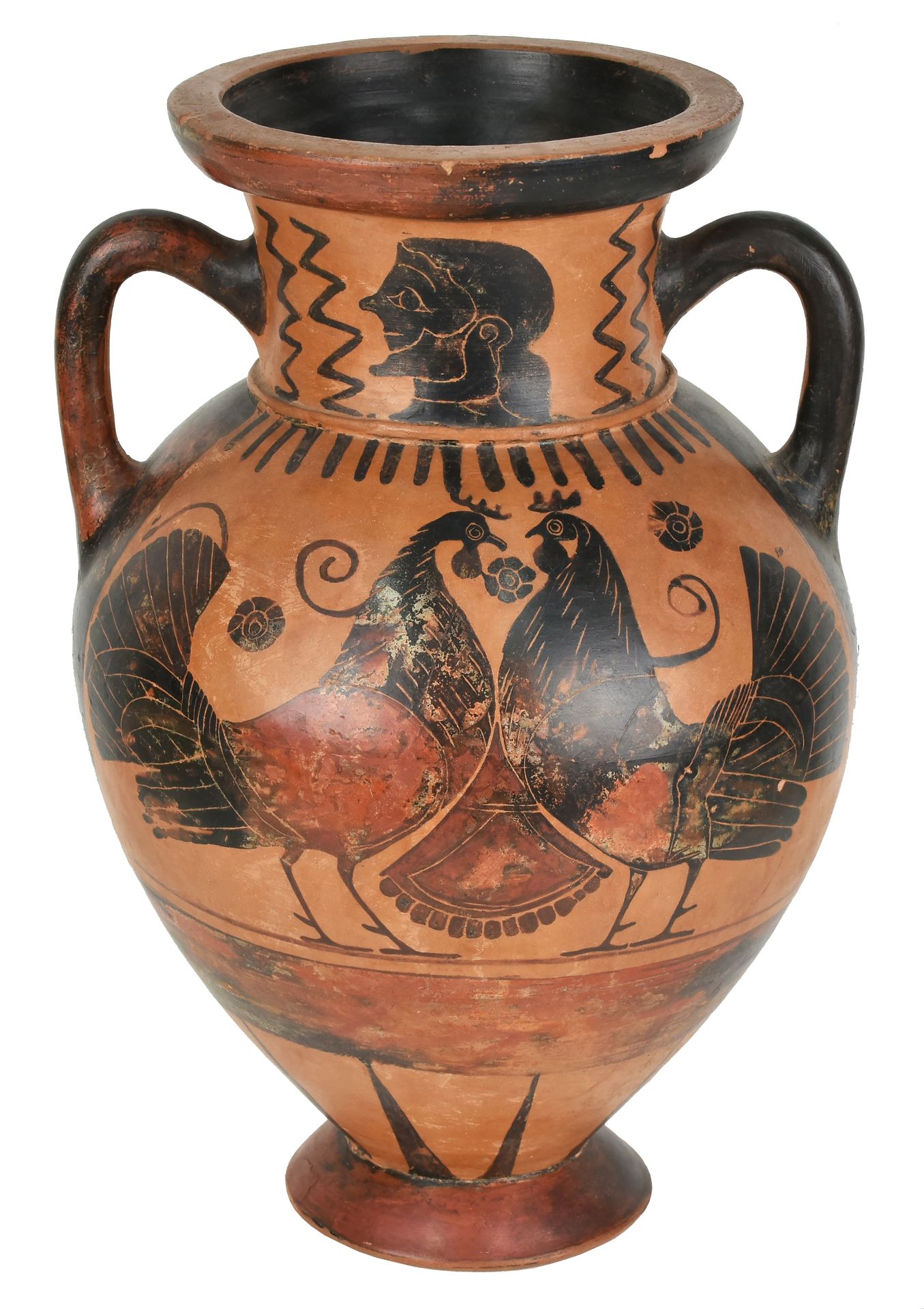Description
IMPORTANT CALCIDIAN AMPHORA DATING: 530-510 sec. BC. C. MATERIAL AND TECHNIQUE: pinkish figulina clay, orange mottling, glossy black paint, modeled in a fast lathe. Lip to echino, high cylindrical neck with concave profile, distinguished from the shoulder rounded by a collar in relief, ovoid body elongated downward, foot echino, stick handles, set from the shoulder to the neck ADDITIONAL DECORATION: painted mouth, handles and foot; on the neck on both sides bearded male profile facing right, between vertical lines tremolo; on the shoulder false baccellatura, wide band under the scene figured, rays attack with the foot DECORATION: side A) two facing roosters standing in heraldic composition with tails open to fan; in the field spirals and rosettes; side B) two standing lions facing in heraldic composition and back with open jaws and hanging tongue; on the back at the top the felines have their tails folded to モSヤ; in the field two rosettes in spots. PRODUCTION: ceramics of Rhegion STATE OF CONSERVATION: integrally reassembled from fragments DIMENSIONS: h. cm 34,3; diam. mouth cm 16 CFR.: M. Iozzo, Vases モCalcidesiヤ del Museo Archeologico Nazionale di Firenze, Pontedera 1996, pp 80-85; tables XXVI-XXIX ORIGIN: Private collection, Turin The Chalcis vases were actually produced by more than one workshop in Rhegion, today's Reggio Calabria during the sixth century BC and were so named by A. Kirchhoff in 1863 for the prevalence of components of Chalcis derivation, compared to those of Heretrius, in the alphabet of Euboic origin with which the painted inscriptions are written. The lot, according to Italian law, is not exportable / This lot, according to Italian law, can not be exported
72
IMPORTANT CALCIDIAN AMPHORA DATING: 530-510 sec. BC. C. MATERIAL AND TECHNIQUE: pinkish figulina clay, orange mottling, glossy black paint, modeled in a fast lathe. Lip to echino, high cylindrical neck with concave profile, distinguished from the shoulder rounded by a collar in relief, ovoid body elongated downward, foot echino, stick handles, set from the shoulder to the neck ADDITIONAL DECORATION: painted mouth, handles and foot; on the neck on both sides bearded male profile facing right, between vertical lines tremolo; on the shoulder false baccellatura, wide band under the scene figured, rays attack with the foot DECORATION: side A) two facing roosters standing in heraldic composition with tails open to fan; in the field spirals and rosettes; side B) two standing lions facing in heraldic composition and back with open jaws and hanging tongue; on the back at the top the felines have their tails folded to モSヤ; in the field two rosettes in spots. PRODUCTION: ceramics of Rhegion STATE OF CONSERVATION: integrally reassembled from fragments DIMENSIONS: h. cm 34,3; diam. mouth cm 16 CFR.: M. Iozzo, Vases モCalcidesiヤ del Museo Archeologico Nazionale di Firenze, Pontedera 1996, pp 80-85; tables XXVI-XXIX ORIGIN: Private collection, Turin The Chalcis vases were actually produced by more than one workshop in Rhegion, today's Reggio Calabria during the sixth century BC and were so named by A. Kirchhoff in 1863 for the prevalence of components of Chalcis derivation, compared to those of Heretrius, in the alphabet of Euboic origin with which the painted inscriptions are written. The lot, according to Italian law, is not exportable / This lot, according to Italian law, can not be exported
